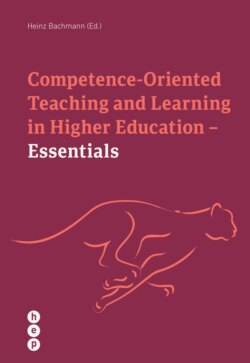Читать книгу Competence Oriented Teaching and Learning in Higher Education - Essentials (E-Book) - Heinz Bachmann - Страница 3
На сайте Литреса книга снята с продажи.
ОглавлениеContent
Preface
Heinz Bachmann
Introduction and structure of the book
Essentials for teachers in higher education
The book’s structure
A focus on student learning
Heinz Bachmann
1Higher education teaching redefined – the shift from teaching to learning
1.1Higher education teaching in view of the Bologna Process
1.2Performing – learning – teaching
1.3On the way to a new teaching-learning culture
1.4Student-centred teaching
1.5Employability – competence orientation – learner orientation
1.6Competence-oriented degree programmes
1.7Competence – a fuzzy concept
1.8Key competences
1.9Competence development
1.10New roles for teachers and students
1.11Summary
1.12Literature
Heinz Bachmann
2Formulating learning outcomes
2.1Learning outcomes contextualised
2.2General considerations regarding the term objective
2.3What are learning outcomes?
2.4Learning objective taxonomies
2.5Subject-specific learning objectives
2.6Transversal learning objectives (key competences)
2.7Check list for formulating learning outcomes
2.8Examples of learning outcomes
2.9Coherence of learning outcomes, teaching methods and forms of assessment
2.10Summary
2.11Literature
Yvo Wüest & Franziska Zellweger
3Strategies to reduce learning content
3.1Too much content – too little time
3.2Reduction – what is the teacher’s task?
3.3Selection and preparation of learning content in four steps
3.4Methods for the reduction of learning content
3.4.1Advance Organizer
3.4.2Identifying key messages
3.4.3Encouraging students to actively engage with learning content
3.5Concluding remarks
3.6Literature
Mònica Feixas & Tobias Zimmermann
4Competence-oriented approaches to assessment
4.1Introduction
4.2Conceptualisation of assessment – what is assessment? 75
4.3How can assessment be approached?
4.3.1Reference standards
4.3.2Some remarks on summative assessment and grading
4.4What to assess? Assessment of competences
4.4.1Assessment of competences
4.4.2How to assess higher-order thinking skills
4.5How to assess? Criteria, tools and procedures
4.5.1Criteria for assessing
4.5.2Quality of assessments
4.5.3Cognitive bias
4.5.4Rubrics
4.5.5Avoiding plagiarism
4.6When to assess?
4.6.1Moments: before, during and after
4.6.2Formative feedback: a reciprocal endeavour
4.7Who can assess? Teacher, external, self-assessment and peer assessment
4.8Assessing students with special educational needs and disabilities (SEND)
4.9Designing an assessment approach
4.10Concluding remarks: a compulsory check-list of ten principles for assessors
4.11Literature
Ulrike Hanke
5Evidence-based teaching – lessons you can learn from psychology for your teaching practice
5.1Learning and its conditions
5.2Consequences for teaching
5.2.1Teaching interventions
5.2.2Teaching intervention: emotionally enriched provocation
5.2.3Teaching intervention: activation of prior knowledge
5.2.4Teaching intervention: information about learning objectives and their relevance
5.2.5Teaching intervention: example-based presentation
5.2.6Teaching intervention: stimulus for reflection
5.2.7Teaching intervention: practice
5.2.8Considering emotions in teaching – environmental aspects
5.2.9Various options
5.2.10Respect and interaction
5.2.11Adequate difficulty and structure
5.3Summary
5.4Literature
Glossary
Appendix
About the editor
